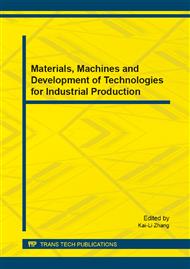[1]
C. Giri, B. Pengra, Z. Zhu, A. Singh, L. Tieszen, Monitoring mangrove forest dynamics of the Sundarbans in Bangladesh and India using multi-temporal satellite data from 1973-2000, Estuar. Coast. Shelf Sci. 73(2007)91-100.
DOI: 10.1016/j.ecss.2006.12.019
Google Scholar
[2]
H.S. Zhang, X.H. Wu, G. Li, P. Qin, Interactions between arbuscular mycorrhizal fungi and phosphate-solubilizing fungus (Mortierella sp. ) and their effects on Kostelelzkya virginica growth and soil enzyme activities of rhizosphere and bulk soils at different salinities, Biol. Fertil. Soils. 47(2011).
DOI: 10.1007/s00374-011-0563-3
Google Scholar
[3]
S.L. Shi, P.H. Huo, J.F. Li, Phosphate solubilizing microorganisms and phosphate solubilizing rhizobium–mini review, Appl. Mech. Mater. 295(2013)2328-2332.
DOI: 10.4028/www.scientific.net/amm.295-298.2328
Google Scholar
[4]
Uva, Growth and yield of beach plum (Prunus maritima Marshall) in horticultural, land restoration, and ecological systems, Ph.D. dissertation, Cornell University, (2003).
Google Scholar
[5]
D.L. Yan, Y.Q. Guo, X.M. Zai, S. W Wan, P. Qin, Effects of electromagnetic fields exposure on rapid micropropagation of beach plum (Prunus maritima) , Ecol. Eng. 35(2009) 597-601.
DOI: 10.1016/j.ecoleng.2008.04.017
Google Scholar
[6]
S.E. Smith, D.J. Read, Mycorrhizal Symbiosis, Academic Press, London, 1997, p.453–469.
Google Scholar
[7]
G.N. Al-Karaki, Growth and mineral acquisition by mycorrhizal tomato grown under salt stress, Mycorrhiza. 10(2000b)51–54.
DOI: 10.1007/s005720000055
Google Scholar
[8]
K. Fang, J.P. Gong, D.L. Yan, The Micropropagation Establishment of Prunus maritime, J. Nanjing Forestry Uni. 40(5) (2006) 491-498.
Google Scholar
[9]
J.M. Phillips, D.S. Hayman, Improved procedure for clearing roots and staining parasitic and vesicular arbuscular mycorrhizal fungi for rapid assessment of infection, Trans. Br. Mycol. Soc. 55(1970)158-161.
DOI: 10.1016/s0007-1536(70)80110-3
Google Scholar
[10]
J.R. Jones, J.B. Wolf, H.A. Mills, Plant analysis handbook, Micro-macro Publishing, Athens, CA, USA., 1991, pp.195-203.
Google Scholar
[11]
M. Jalaluddin, Effect of VAM fungus (Glomus intraradices) on the growth of sorghum, maize, cotton and pennisetum under salt stress, Pak. J. Bot. 25(1993)215–218.
Google Scholar
[12]
G.M. Al-Karaki, Growth of mycorrhizal tomato and mineral acquisition under salt stress, Mycorrhiza. 10(2000) 51–54.
DOI: 10.1007/s005720000055
Google Scholar
[13]
H. Evelin, R. Kapoor, B. Giri, Arbuscular mycorrhizal fungi in alleviation of salt stress: areview, Ann. Bot-London. 104(7) (2009)1263-1280.
DOI: 10.1093/aob/mcp251
Google Scholar
[14]
G. Manchanda, N. Garg, Alleviation of salt-induced ionic, osmotic and oxidative stresses in Cajanus cajan nodules by AM inoculation, Plant Biosyst. 145(1) (2011) 88-97.
DOI: 10.1080/11263504.2010.539851
Google Scholar
[15]
A.G. Jarstfer, P. Farmer-Koppenol, D.M. Sylvia, Tissue magnesium and calcium affect arbuscular mycorrhiza development and fungal reproduction, Mycorrhiza. 7(1998)237–242.
DOI: 10.1007/s005720050186
Google Scholar
[16]
B.K. Garg, Role of calcium in plants under salt stress, Ann. Arid. Zone. 37(1998)107–118.
Google Scholar
[17]
G.S. Pattinson, K.A. Hammill, B.G. Sutton, P.A. Mcgee, Simulated fire reduces the density of arbuscular mycorrhizal fungi at the soil surface, Mycol. Res. 103(1999)491–496.
DOI: 10.1017/s0953756298007412
Google Scholar


